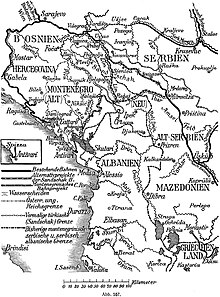Sandschakbahn
The Sandschak Railway (also Sandžak Railway ) was a standard-gauge railway line in the Ottoman Empire in Southeast Europe , newly initiated in 1908 by Lexa von Aehrenthal based on the original plans of the Orient Railway , and which was the railway connection between the narrow-gauge Bosnian Eastern Railway in Vardište and the existing one The terminus of the standard gauge Orient Railway at Kosovska Mitrovica was supposed to be established. The announcement of the receipt of the concession to examine the route by the Ottoman Empire on January 27, 1908 subsequently led to a European crisis in which Austria-Hungary gained a political advantage on the Balkan Peninsula, but damaged its relationship with the Triple Alliance and Serbia.
history
The idea of building a railroad through the Sanjak Novi Pazar dates back to the late 1860s. In 1869, the Chemins de fer Orientaux received from Baron Maurice de Hirsch, among other things, the concession to build the railway lines Istanbul / Thessaloniki - Mitrovica - Sandschak - Sarajevo - Banja Luka - Austrian border near Doberlin ( Dobrljin ).
Access to the Aegean port of Thessaloniki was particularly important for Austria-Hungary . However, this project was only partially implemented: the kuk military railway Banjaluka - Doberlin via Novi (opening: December 24, 1872) and Thessaloniki - Mitrovica (1874). The rest, especially the actual sanjak line, remained largely unexecuted. Only smaller projects were implemented: in 1882 Banja Luka was connected to the network of the Austro-Hungarian Monarchy via Doberlin - Sunja - Sisak ( railway line Zagreb – Belgrade from 1891; today's Croatian R102 and parts of the M104 ). In 1906 the 760-mm-gauge Bosnian Eastern Railway (Sarajevo– Uvac ) was opened to traffic. Its substructure was already designed for the standard gauge, i.e. part of the Vienna – Sandschak – Saloniki project.
A standard gauge closing of the gap between Banja Luka and Sarajevo (via Jajce ) on the one hand and between Uvac, Novi Pazar and Mitrovica on the other hand was so complex that it was never carried out. The former railway minister Heinrich von Wittek therefore brought the narrow-gauge construction of the Sandschakbahn into the discussion in an article published in 1917. He had two options in mind: the line via Novi Pazar and the line through the Lim valley . However, due to the outcome of the First World War , the project finally came to a standstill.
literature
- Elmar Oberegger : The "Great Departure" into the Aegean. The failed railway project Vienna-Sarajevo-Saloniki (1874–1914). Information office for Austrian railway history, Sattledt 2009 ( publication of the information office for Austrian railway history 2009, 2, ZDB -ID 2278238-2 ).
- Arthur J. May 1938: The Novibazar Railway Project. The Journal of Modern History Vol. 10, No. 4 (December 1938), 496-527, Chicago University Press.
- Arthur J. May 1952: Trans-Balkan Railway Schemes. The Journal of Modern History, No. 24/4 (Dec. 1952), pp. 352-367.
- Norman JG Pounds, A historical geography of Europe 1800-1914 . Historical Geography of Europe, 3, pp. 457-460, Cambridge University Press.
- Oscar Remy 1927: Sandšak Railway and Danube Adriatic Railway, a chapter in the prehistory of the World War . Archives for Railways, 1927, Issue 5, September – October, Part One, 1189–1247, Springer, Berlin.
- Momir Samardžić 2012: Trans-Balkan railway schemes and Italy (late 19th - early 20th century). Etudes balkaniques, No. 2–3, 120–129.
- Orme Wilson Jr., Guido G. Weigend: The Belgrade-Bar railroad: an essay in economic and political geography. GW Hofmann (Ed.) Eastern Europe: Essays in Geographical problems, Methuen, London 1971, pp. 365-393.
- Heinrich Wittek: Sandschakbahn. In: Freiherr von Röll et al. (Ed.): Encyclopedia of the Railway System. Volume 8: Passenger tunnel - Schynige Platte Railway. 2nd completely revised edition. Urban & Schwarzenberg, Berlin et al. 1917, pp. 299-300, online .
Individual evidence
- ^ Solomon Wank 1964: Aehrenthal and the Snajak ov Novibazar Railway Project: a Reappraisal . In: Slavonic and East European Review, Jun 1. 1964; 42, 353-369
- ↑ a b K.K. Military railway Banja Luka – Doberlin. Elmar Oberegger: Railway history , 2009.
- ↑ Volkswirthschaftliche Zeitung. […] The opening of the company on the… In: Das Vaterland , January 4, 1873 ( eReader , anno.onb)
